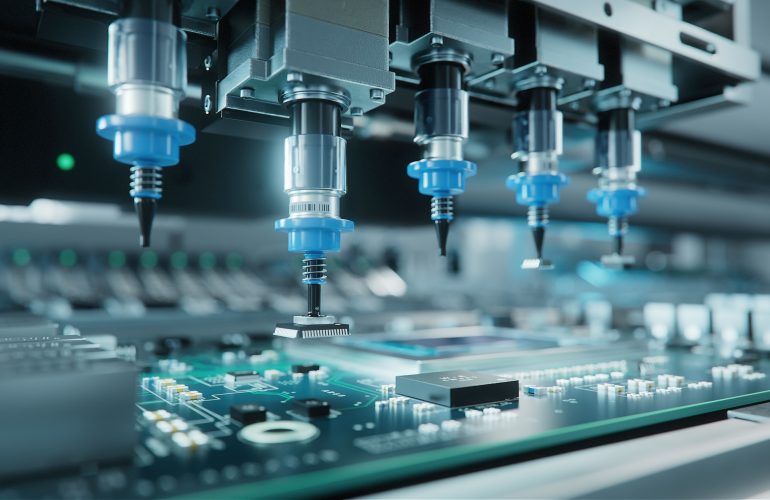The electronics industry finds itself at a pivotal point. With the global amount of electronic waste expected to grow to 74 million tonnes by 2030, the electronics industry is under growing pressure to alter their production processes. Sustainable manufacturing is now more than a mere environmental imperative, but it’s also an essential competitive advantage that is fundamentally changing the way electronic devices are developed, manufactured, and then eliminated.
The Environmental Impact of Electronics
Electronic manufacturing has always encapsulated the environmental burden. Producing one smartphone is a process that requires the mining of rare earth elements from various continents, which consumes around 24 gallons of water and produces significant carbon emissions. Manufacturing processes in the traditional way often place the speed of production and costs over environmental concerns, which results in products that are built for a short lifespan rather than long-lasting. This linear process of take, make, and dispose of has led to a growing problem in electronic garbage that includes hazardous substances such as mercury, lead, and cadmium. These chemicals can be leaching into groundwater and soil if not properly removed, posing grave health hazards to people across the globe. The electronics industry alone accounts for a quarter of the global greenhouse gas emissions, and this figure will continue to rise as the use of devices increases across emerging markets.
The Rise of Sustainable Practices
Innovative electronics companies are incorporating sustainable practices into their primary business strategies, rather than considering them as a secondary consideration. This trend has been accelerated by the demand from consumers for eco-friendly products and the fact that seventy-three percent of young people want to spend more money on sustainable electronic products. Apple and other companies have committed to attaining carbon neutrality across all their supply chains by 2030. Samsung has poured billions of dollars into renewable energy to power its manufacturing facilities. Europe’s Right to Repair legislation has added to this trend by requiring that manufacturers develop products to be repairable and supply spare parts for longer periods of time. These rules are causing an international ripple effect that is encouraging companies around the world to adopt more sustainable strategies to stay competitive in international markets.
Key Strategies for Sustainability
Electronics companies are using various methods to reduce their carbon footprint throughout the entire lifecycle of production. The selection of materials has become a major factor, and companies are increasingly choosing recycled plastics and bio-based products as well as conflict-free minerals. Modular design principles permit users to upgrade certain components, rather than replace entire devices, which significantly extends the life of products. Manufacturing processes that are energy efficient, such as the use of sustainable energy sources as well as optimized production schedules, assist in reducing emissions from operations. Closed-loop manufacturing reduces the use of resources, and modern packaging methods eliminate waste material and lower emissions during shipping. Many manufacturers are also using take-back programs to ensure that devices at the end of their life are recycled and valuable materials are recovered for use in the future.
Benefits of Sustainable Manufacturing
Beyond environmental protection, the shift towards sustainable manufacturing yields significant benefits. Cost savings can be seen through reduced production waste, less energy consumption, and a reduced cost of regulatory compliance. Businesses report improved brand recognition, increased customer loyalty, and sustainability practices are becoming significant differentiators in a highly competitive market. Supply chain resilience improves when manufacturers diversify their sources of materials and lessen dependence on finite resources. Innovation increases as sustainability-related constraints stimulate creative problem-solving, leading to the development of breakthrough technologies such as biodegradable and flexible electronics. Engagement of employees generally improves when employees feel connected to sustainable environmental goals, which can result in increasing the rate of turnover and attracting the top talent. The multifaceted benefits of these initiatives result in positive feedback loops, which strengthen the argument for sustainable methods.
Challenges and Opportunities
Despite substantial advancements in sustainable manufacturing, it is facing significant problems that require continuous improvement and cooperation. Initial capital investments in sustainable technology can be huge, which could deter smaller companies from adopting sustainable practices. Global supply chains are complex, making it difficult to maintain the highest standards of sustainability for all partners and suppliers. Consumer behavior can also pose problems, since the need to upgrade their products frequently is in conflict with the sustainability objective of longer product lifecycles. But these issues provide opportunities for innovative innovation and new business models. The increasing demand for refurbished electronics is expected to reach $65.5 billion by the year 2030, reflecting consumers’ growing desire for more sustainable options. Machine learning and artificial intelligence enable more efficient use of resources and predictive maintenance, whereas blockchain technology allows transparency in the sustainability of supply chains.
The Future of Electronics Manufacturing
Sustainable manufacturing goes beyond an environmental necessity. It’s the basis for a robust and highly innovative electronics industry. Those committed to sustainability will gain significant competitive advantages as technology advances and public awareness rises. This transformation involves collaboration across the entire value chain, starting from the raw material supplier to consumers who purchase the final product. The success of this transformation is based on seeing sustainability not as a limitation but rather as a driver for innovation that will drive the future of electronics. Companies that embrace this shift will not just aid in environmental protection but also become pioneers in the rapidly changing electronic landscape.
FAQs
1. What is sustainable manufacturing in electronics?
The process of sustainable manufacturing for electronics entails creating, manufacturing, and disposing of electronic devices with a focus on minimizing the environmental impact while ensuring economic viability.
2. How can sustainable manufacturing lower the cost of manufacturing?
It lowers costs by reducing material waste, lessening energy consumption, lowering costs for regulatory compliance, and increasing operational efficiency.
3. What are the most pressing issues facing the environmentally sustainable manufacturing of electronics?
The key challenges are high initial capital investment, worldwide supply chains, evolving consumer habits, and the need for collaboration across the entire industry.




